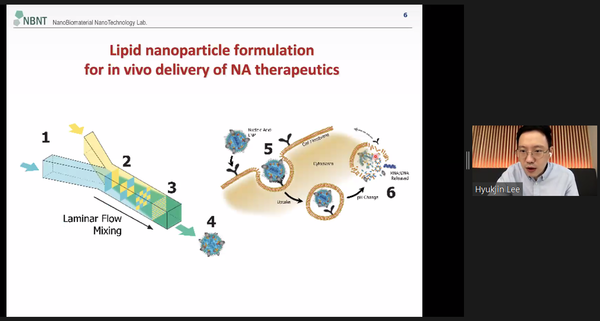It is necessary to understand the body's mechanism accurately to deliver micro ribonucleic acid or deoxyribonucleic acid substances targeting genetic diseases.

Ewha Womans University Graduate School of Pharmaceutical Sciences Professor Lee Hyuk-jin made the point while explaining the development of RNA therapeutics and lipid nanoparticle (LNP) formulation for in vivo delivery at an online symposium on RNA biology and therapeutics hosted by the Institute for Basic Science and Seoul National University Wednesday.
An mRNA needs protection to keep it from disintegrating. Therefore, it must be carried and released from the endosome when it reaches the cell. When lipid nanoparticles (LNP) containing mRNA reach the cell, they undergo ionization and move into the cell.
"Speaking of mRNA, it has a lot of advantages in expressing target proteins compared to the conventional plasmid DNA," Lee said.
For example, DNA and mRNA transfection shows very differently intracellular trafficking pathways because DNA needs to go into the nucleus for transcription, while mRNA begins expression when delivered to the cytoplasm, he explained.
LNPs are multicomponent lipid systems containing an ionizable lipid, a phospholipid, cholesterol, and a PEG-lipid. LNP systems are currently considered the most clinically advanced non-viral gene delivery system, safely and effectively delivering nucleic acids.
While maintaining a stable endosomal structure until delivery, it is structured for mRNA to escape the structure and be inserted through the ionization process when penetrating between the plasma membranes, Lee said.
"There is also a method of assigning features to the surface of a single cell that targets a specific organ, introducing a ligand or modifying the profile of a protein adsorbed to the cell surface differently," Lee said. "When selecting a ligand, it is necessary to check first whether the candidate substance could be ionized or not."
However, he pointed out that mRNA still has limits to staying at a local delivered level. Since mRNA itself is easily degraded in the body, devices such as modified RNAs, vectors, and conjugates are required.
Much less attention has been paid to LNP before when researchers began developing gene therapies.
"Synthetic mRNA is a very good system for the rapid onset expression of target proteins, and delivery of this mRNA using lipid nanoparticle is a good way for in vivo expression of the mRNA," Lee said. "It has a potential to be applied to various drugs to replace the protein therapeutics and used as the mRNA vaccines."

